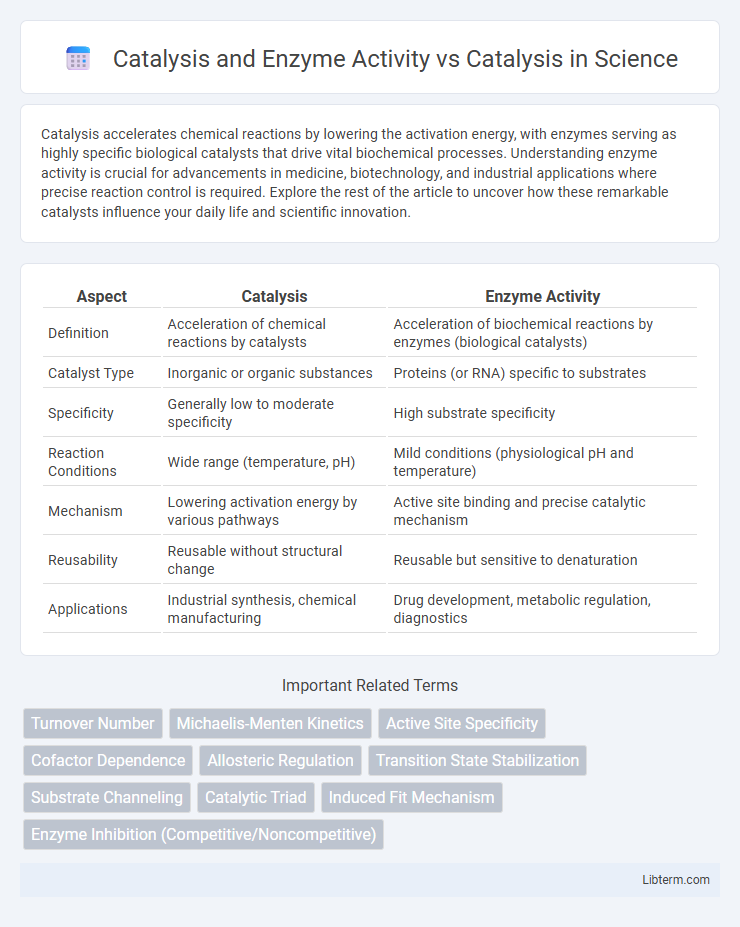Catalysis accelerates chemical reactions by lowering the activation energy, with enzymes serving as highly specific biological catalysts that drive vital biochemical processes. Understanding enzyme activity is crucial for advancements in medicine, biotechnology, and industrial applications where precise reaction control is required. Explore the rest of the article to uncover how these remarkable catalysts influence your daily life and scientific innovation.
Table of Comparison
| Aspect | Catalysis | Enzyme Activity |
|---|---|---|
| Definition | Acceleration of chemical reactions by catalysts | Acceleration of biochemical reactions by enzymes (biological catalysts) |
| Catalyst Type | Inorganic or organic substances | Proteins (or RNA) specific to substrates |
| Specificity | Generally low to moderate specificity | High substrate specificity |
| Reaction Conditions | Wide range (temperature, pH) | Mild conditions (physiological pH and temperature) |
| Mechanism | Lowering activation energy by various pathways | Active site binding and precise catalytic mechanism |
| Reusability | Reusable without structural change | Reusable but sensitive to denaturation |
| Applications | Industrial synthesis, chemical manufacturing | Drug development, metabolic regulation, diagnostics |
Introduction to Catalysis and Enzyme Activity
Catalysis accelerates chemical reactions by lowering activation energy, a principle central to both inorganic and biological systems. Enzyme activity represents a specialized form of catalysis where protein catalysts enhance reaction rates with substrate specificity and regulation under physiological conditions. Understanding the mechanisms of catalysis and enzyme activity is essential for applications in biotechnology, pharmaceuticals, and industrial chemistry.
Defining Catalysis: Principles and Mechanisms
Catalysis involves accelerating chemical reactions by lowering activation energy through a catalyst, which remains unchanged after the reaction. Enzyme activity, a subset of catalysis, utilizes biological macromolecules that provide highly specific active sites to stabilize transition states and facilitate substrate conversion efficiently under mild conditions. Fundamental principles of catalysis include adsorption of reactants, transition state stabilization, and product desorption, with mechanisms varying from acid-base catalysis to covalent catalysis and proximity effects.
Enzyme Activity: Nature’s Catalysts in Action
Enzyme activity represents the precision and efficiency of nature's catalysts, accelerating biochemical reactions under mild conditions with remarkable specificity. Unlike general catalysis, which often relies on inorganic catalysts and harsh environments, enzyme activity is governed by the enzyme's unique active site, substrate affinity, and regulatory mechanisms. This biological catalysis is crucial for metabolism, enabling life-sustaining processes through controlled reaction rates and high turnover numbers.
Comparing Chemical and Biological Catalysts
Catalysis involves increasing reaction rates by lowering activation energy, with chemical catalysts typically being inorganic substances such as metals or metal oxides operating under a wide range of temperatures and pH levels. Enzyme activity, a subset of catalysis, relies on highly specific biological catalysts composed of proteins that function efficiently under mild physiological conditions and exhibit substrate specificity. Comparing chemical and biological catalysts reveals enzymes offer superior selectivity and efficiency, while chemical catalysts provide greater robustness and versatility in industrial processes.
Catalytic Efficiency: Enzymes vs Traditional Catalysts
Enzymes exhibit superior catalytic efficiency compared to traditional catalysts due to their highly specific active sites and ability to lower activation energy under mild conditions. While traditional catalysts often require high temperatures and pressures, enzymes achieve turnover rates that can be millions of times faster, enhancing reaction specificity and yield. The unique protein structures and substrate-binding affinities in enzymes contribute to their remarkable selectivity and catalytic prowess in biochemical reactions.
Specificity in Catalysis: Enzymatic vs Non-Enzymatic Methods
Enzymatic catalysis exhibits high specificity due to the precise active site structure that recognizes and binds substrates, facilitating targeted biochemical reactions with minimal side products. Non-enzymatic catalysis lacks this molecular recognition, often resulting in broader substrate ranges but reduced selectivity and efficiency. The specificity in enzymatic catalysis enhances reaction rates and metabolic regulation, whereas non-enzymatic methods rely on physicochemical factors like temperature and pH to influence catalyst behavior.
Environmental Impact: Green Catalysis with Enzymes
Green catalysis with enzymes significantly reduces environmental impact by promoting sustainable chemical reactions under mild conditions, minimizing energy consumption and hazardous waste production. Enzymatic catalysis offers high specificity and efficiency, enabling the use of renewable resources and biodegradable materials, which contrasts with traditional catalysis relying on heavy metals and harsh chemicals. This eco-friendly approach supports the development of cleaner industrial processes, helping to lower greenhouse gas emissions and chemical pollution.
Industrial Applications: Catalysts vs Enzymatic Processes
Catalysts in industrial applications accelerate chemical reactions by lowering activation energy, enabling efficient processes such as petroleum refining and polymer production. Enzymatic processes offer high specificity and operate under mild conditions, making them ideal for pharmaceuticals, food processing, and biofuel production. The choice between traditional catalysts and enzymatic methods depends on factors like reaction requirements, environmental impact, and cost-effectiveness in large-scale manufacturing.
Recent Advances in Enzyme Engineering and Catalysis
Recent advances in enzyme engineering have significantly enhanced catalytic efficiency and substrate specificity, employing techniques such as directed evolution and computational design to tailor enzyme activity for industrial applications. Innovations in protein engineering enable the creation of novel biocatalysts with improved stability under extreme conditions, expanding their use in green chemistry and pharmaceutical synthesis. These developments highlight the critical role of enzymes in sustainable catalysis, outperforming traditional chemical catalysts through high selectivity and environmentally friendly processes.
Future Perspectives: Synergy between Enzymatic and Conventional Catalysis
Future perspectives in catalysis emphasize the synergy between enzymatic and conventional catalytic methods to enhance reaction efficiency and selectivity. Integrating enzyme activity with traditional catalytic processes enables the development of hybrid catalysts that combine the substrate specificity and mild operation conditions of enzymes with the robustness and scalability of chemical catalysts. This convergence paves the way for sustainable and innovative applications in pharmaceuticals, biotechnology, and green chemistry industries.
Catalysis and Enzyme Activity Infographic

 libterm.com
libterm.com